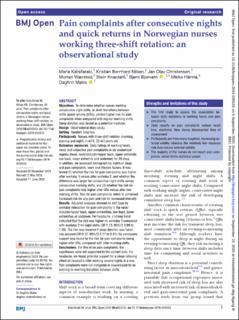| dc.description.abstract | Objectives To determine whether nurses working consecutive night shifts, or short transitions between shifts (quick returns (QRs)), yielded higher risk for pain complaints when compared with regular morning shifts. Sleep duration was tested as a potential mediator. Design Observational diary study. Setting Random hospitals. Participants Nurses with three-shift rotation (morning, evening and night), n=679, 22–63 years old. Outcomes measures Daily ratings of working hours, sleep and subjective pain complaints in six anatomical regions (head, neck/shoulder/upper back, upper extremity, low back, lower extremity and abdomen) for 28 days. In addition, we assessed demographics, habitual sleep and pain complaints, work and lifestyle factors. It was tested (1) whether the risk for pain complaints was higher after workday 3 versus after workday 2, and whether the difference was larger for consecutive night shifts versus consecutive morning shifts, and (2) whether the risk for pain complaints was higher after QRs versus after two morning shifts. Risk for pain complaints refers to combined increased risk for any pain and risk for increased intensity. Results Adjusted analyses showed no shift type by workday interaction for pain complaints in the neck/shoulder/upper back, upper extremities, low back, lower extremities or abdomen. For headache, a strong trend indicated that the risk was higher on workday 3 compared with workday 2 for night shifts (OR 1.13, 95% CI 0.99 to 1.28). The risk was lowered if sleep duration was taken into account (OR 0.37, 95% CI 0.17 to 0.81). No conclusive support was found for the risk for pain complaints being higher after QRs, compared with after morning shifts. Conclusions For five of six pain complaints, the hypotheses were not supported by the current data. For headache, we found potential support for a sleep-relieving effect on headache after working several nights in a row. Pain complaints were not instigated or exacerbated by an evening-to-morning transition between shifts. | en_US |

